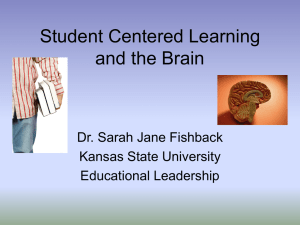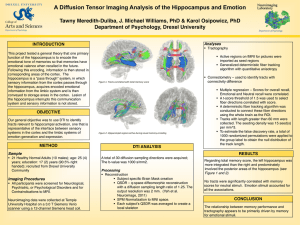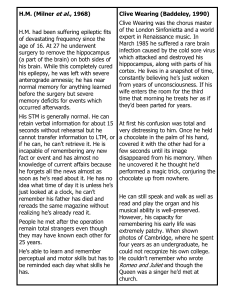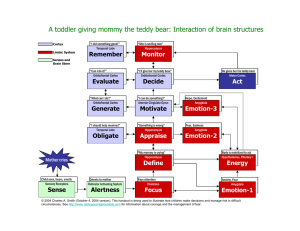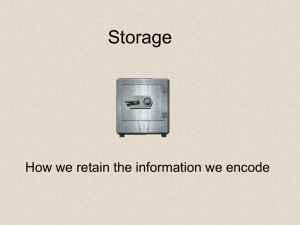EDITORIAL Hippocampus and Its Interactions Within the Medial Temporal Lobe
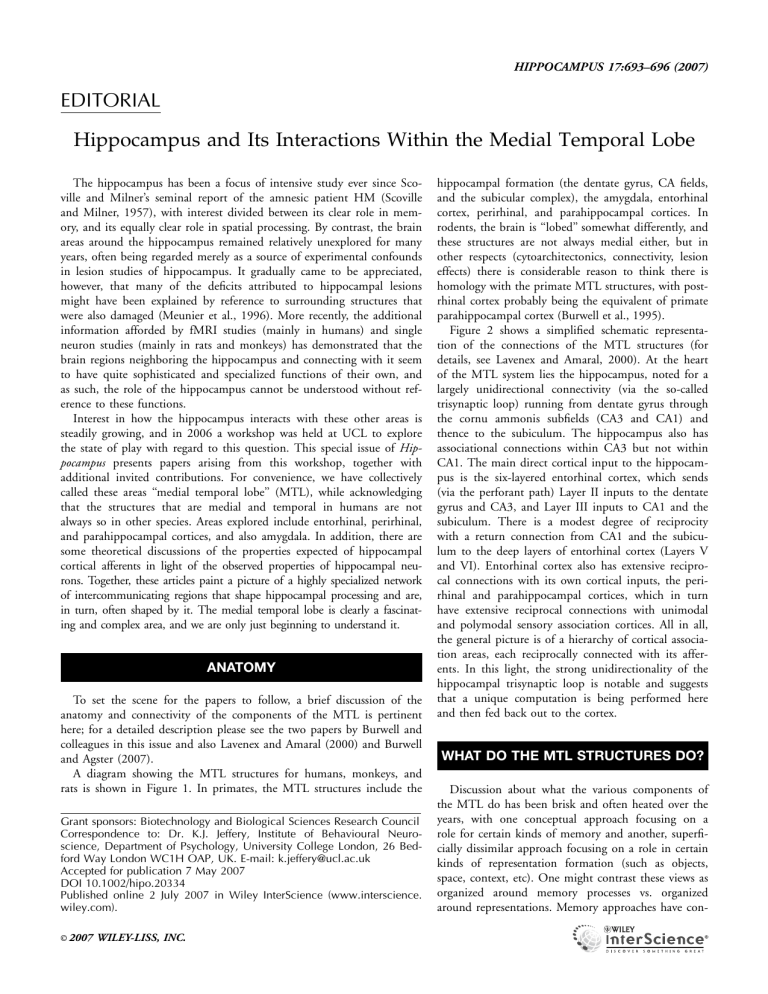
HIPPOCAMPUS 17:693–696 (2007)
EDITORIAL
Hippocampus and Its Interactions Within the Medial Temporal Lobe
The hippocampus has been a focus of intensive study ever since Scoville and Milner’s seminal report of the amnesic patient HM (Scoville and Milner, 1957), with interest divided between its clear role in memory, and its equally clear role in spatial processing. By contrast, the brain areas around the hippocampus remained relatively unexplored for many years, often being regarded merely as a source of experimental confounds in lesion studies of hippocampus. It gradually came to be appreciated, however, that many of the deficits attributed to hippocampal lesions might have been explained by reference to surrounding structures that were also damaged (Meunier et al., 1996). More recently, the additional information afforded by fMRI studies (mainly in humans) and single neuron studies (mainly in rats and monkeys) has demonstrated that the brain regions neighboring the hippocampus and connecting with it seem to have quite sophisticated and specialized functions of their own, and as such, the role of the hippocampus cannot be understood without reference to these functions.
Interest in how the hippocampus interacts with these other areas is steadily growing, and in 2006 a workshop was held at UCL to explore the state of play with regard to this question. This special issue of Hippocampus presents papers arising from this workshop, together with additional invited contributions. For convenience, we have collectively called these areas ‘‘medial temporal lobe’’ (MTL), while acknowledging that the structures that are medial and temporal in humans are not always so in other species. Areas explored include entorhinal, perirhinal, and parahippocampal cortices, and also amygdala. In addition, there are some theoretical discussions of the properties expected of hippocampal cortical afferents in light of the observed properties of hippocampal neurons. Together, these articles paint a picture of a highly specialized network of intercommunicating regions that shape hippocampal processing and are, in turn, often shaped by it. The medial temporal lobe is clearly a fascinating and complex area, and we are only just beginning to understand it.
ANATOMY
To set the scene for the papers to follow, a brief discussion of the anatomy and connectivity of the components of the MTL is pertinent here; for a detailed description please see the two papers by Burwell and colleagues in this issue and also Lavenex and Amaral (2000) and Burwell and Agster (2007).
A diagram showing the MTL structures for humans, monkeys, and rats is shown in Figure 1. In primates, the MTL structures include the
Grant sponsors: Biotechnology and Biological Sciences Research Council
Correspondence to: Dr. K.J. Jeffery, Institute of Behavioural Neuroscience, Department of Psychology, University College London, 26 Bedford Way London WC1H OAP, UK. E-mail: k.jeffery@ucl.ac.uk
Accepted for publication 7 May 2007
DOI 10.1002/hipo.20334
Published online 2 July 2007 in Wiley InterScience (www.interscience.
wiley.com).
hippocampal formation (the dentate gyrus, CA fields, and the subicular complex), the amygdala, entorhinal cortex, perirhinal, and parahippocampal cortices. In rodents, the brain is ‘‘lobed’’ somewhat differently, and these structures are not always medial either, but in other respects (cytoarchitectonics, connectivity, lesion effects) there is considerable reason to think there is homology with the primate MTL structures, with postrhinal cortex probably being the equivalent of primate parahippocampal cortex (Burwell et al., 1995).
Figure 2 shows a simplified schematic representation of the connections of the MTL structures (for details, see Lavenex and Amaral, 2000). At the heart of the MTL system lies the hippocampus, noted for a largely unidirectional connectivity (via the so-called trisynaptic loop) running from dentate gyrus through the cornu ammonis subfields (CA3 and CA1) and thence to the subiculum. The hippocampus also has associational connections within CA3 but not within
CA1. The main direct cortical input to the hippocampus is the six-layered entorhinal cortex, which sends
(via the perforant path) Layer II inputs to the dentate gyrus and CA3, and Layer III inputs to CA1 and the subiculum. There is a modest degree of reciprocity with a return connection from CA1 and the subiculum to the deep layers of entorhinal cortex (Layers V and VI). Entorhinal cortex also has extensive reciprocal connections with its own cortical inputs, the perirhinal and parahippocampal cortices, which in turn have extensive reciprocal connections with unimodal and polymodal sensory association cortices. All in all, the general picture is of a hierarchy of cortical association areas, each reciprocally connected with its afferents. In this light, the strong unidirectionality of the hippocampal trisynaptic loop is notable and suggests that a unique computation is being performed here and then fed back out to the cortex.
WHAT DO THE MTL STRUCTURES DO?
Discussion about what the various components of the MTL do has been brisk and often heated over the years, with one conceptual approach focusing on a role for certain kinds of memory and another, superficially dissimilar approach focusing on a role in certain kinds of representation formation (such as objects, space, context, etc). One might contrast these views as organized around memory processes vs. organized around representations. Memory approaches have con-
2007 WILEY-LISS, INC.
694
JEFFERY
FIGURE 1.
Diagram showing comparative views of medial temporal lobe structures for the human (left) and monkey
(middle) and the homologous structures for the rat (right). The upper panel shows lateral views of the human brain (A), the monkey brain (B), and the rodent brain (C). The lower panel shows unfolded maps of the relevant cortical structures for the human brain (D), the monkey brain (E), and the rodent brain (F). Layer
IV was unfolded for the maps of the human and monkey perirhinal (PER) areas 35 and 36, parahippocampal (PH) areas TF and
TH, and entorhinal (EC). The pial surface was unfolded for the maps of the rat PER areas 35 and 36, the postrhinal cortex
(POR), and the lateral and medial entorhinal areas (LEA and
MEA) (unfolded maps adapted from (Burwell et al., 1995) and
(Insausti et al., 1995). The rodent POR is the homolog of the primate PH. Other abbreviations: cs, collateral sulcus; ParaS, parasubiculum; rs, rhinal sulcus. Figure is from (Burwell and Agster,
2007), with permission. [Color figure can be viewed in the online issue, which is available at www.interscience.wiley.com.] centrated on determining what processes act on stored information, with hypotheses suggesting that MTL structures are differentiated based on the memory process they support (e.g., familiarity vs. explicit recall). Representational approaches on the other hand have concentrated more on the nature of the information being handled (e.g., space by one structure, objects by another, and so on), and less on the processes acting on this information. Of course, memory processes and representations are very much interwoven, and modern theories tend towards specifying both (certain kinds of process operating on certain kinds of perceptual input to produce certain kinds of representation).
Attempts to compartmentalize the MTL along memory lines have been legion: this area has been implicated in a variety of memory processes including declarative memory (Cohen and
Squire, 1980), episodic memory (Vargha-Khadem et al., 1997), relational learning (Cohen et al., 1997), familiarity (Yonelinas et al., 1998), novelty and mismatch detection (Kumaran and
Maguire, 2006; see also Kumaran and Maguire, this issue), and pattern separation and completion (O’Reilly and McClelland,
1994). It is now generally accepted that the MTL as a whole is somehow involved in the processing of memory for personally experienced (autobiographical or episodic) events, but the exact nature of its contribution remains elusive. One current controversy concerns whether this kind of memory can be functionally dissociated into familiarity vs. explicit recall, and—if so—which structures might support which process. Another controversy concerns whether the MTL—and in particular, the hippocampus—is involved in so-called ‘‘relational’’ or ‘‘configural’’ encod-
FIGURE 2.
Schematic drawing of interconnections between structures in the MTL system, adapted from (Lavenex and Amaral, 2000).
Hippocampus
DOI 10.1002/hipo
EDITORIAL
695 ing, involving the formation of associative connections between items such that the uniqueness of the representation lies not in the elements of it, but in how these are combined, or related.
Representational approaches have tended to focus more on the specific sensory data handled, and the kind of knowledge structure created in each MTL area. The first and most influential proposal along these lines was O’Keefe and Nadel’s proposition (O’Keefe and Nadel, 1978) that the hippocampus is primarily interested in spatial information, with its function being to construct a cognitive map of space, based on information from static environmental features together with dynamic information arising from the animal’s movements. This proposition was more recently expanded to incorporate nonspatial information in the form of a context representation (Nadel et al.,
1985; Mizumori et al., 1999; Jeffery et al., 2004), or as the framework of an episodic memory system (Eichenbaum et al.,
1999). Having proposed a representational structure within hippocampus itself, a natural development was to posit related structures in afferent regions: thus, perirhinal cortex has been viewed as constructing a representation of objects (Mumby and
Pinel, 1994; Buffalo et al., 2006), one purpose of which may be to supply hippocampus with landmark information. Similarly, parahippocampal cortex has been viewed as constructing
‘‘scenes’’ (Epstein and Kanwisher, 1998) that could be combined with directional information (in the head direction network) to form a viewpoint-independent, allocentric representation of space (Burgess, 2002). How these representations link with the putative role of MTL in memory processes has been hard to reconcile. It is likely that in the end, the MTL will turn to be organized along both representational and memory lines, to varying degrees in different structures (see Bussey and
Saksida, this issue, for a more detailed discussion of this topic).
The special issue begins with articles focusing on the role of the hippocampus itself, first from neuropsychological perspectives and then with articles drawing more heavily on electrophysiological data. Aggleton et al. begin by addressing the question of what processing the hippocampus itself contributes, and review previous attempts to categorize it as a relational, declarative, or configural memory system before concluding that these previous views either do not account for all the data, or are not sufficiently specific as to pin down the exact domain of processing. They argue instead for a role for the hippocampus in ‘‘structural learning,’’ which is a specific form of configural learning whereby spatial location (and possibly temporal order) is one of the to-be-configured elements. This is an interesting development of configural theory because it converts a purely memory process description into one having some representational constraints (space and/or time). Kumaran and Maguire similarly take a somewhat hybrid view of hippocampal function arguing for its role in making comparisons between incoming sensory data sets in order to generate a novelty (or ‘‘mismatch’’) signal, particularly within the domains of associative and contextual novelty. Taking a slightly different approach, Ji and
Maren discuss the role of the hippocampus in mediating the context-specificity of extinction, via its role in processing context. This is a view that parallels in McDonald’s proposal of a context-mediated role for the hippocampus in mediating retrograde amnesia for a visual discrimination, and one that tallies with the growing recognition that hippocampus is important in memory processes relying on a representation of ‘‘context’’
(whatever that may be).
The next set of articles take data from electrophysiological studies, in rodents and primates, and draw inferences about
MTL function based on the properties of the observed neuronal behavior. Jeffery, adopting a more representationalist stance, begins with a review of how the hippocampal place cells integrate sensory information, concluding that evidence suggests a functional dissociation between metric and non-metric inputs in the afferents, with the latter selecting (or ‘‘gating’’) the former. Barry and Burgess focus on the metric inputs and show how an existing model of how these drive place cells can be adapted to allow for plasticity, using experimental data to both shape and test the model. Burgess et al. then move outwards from hippocampus to entorhinal cortex, and propose a model of how entorhinal grid cell firing patterns could be generated by the interference pattern from two interacting oscillatory processes. Bilkey describes a way in which subtle alterations to place fields could come to encode a relationship between current location and goals, and posits a way in which extrahippocampal structures could contribute information needed to specify this encoding. Hargreaves et al. present electrophysiological data showing that the spatial firing of neurons in regions surrounding the hippocampus can, like the place cells, be influenced by both external landmarks and internal ( idiothetic ) directional cues, and neurons in all of these regions seem to behave coherently, suggesting either an integrated network or, more likely, one controlled by a common signal (probably from the head direction system). Suzuki turns attention to data from primate hippocampal and cortical recordings during conditional motor learning, and shows that neurons in several areas, including hippocampus and also prefrontal cortex and striatum, exhibit learning-related changes in activity that may reflect association formation. Mizumori concludes the single neuron section of papers with a review of hippocampal and
MTL data that suggest a role in the processing of context: specifically in the discrimination of ‘‘meaningful’’ contexts.
The final set of papers concentrate on structures upstream of the hippocampus and make inferences about the kind of processing they instantiate, based on the results from behavioral, lesion, and fMRI studies. Eacott and Easton begin with a review of the problem in MTL studies of dissociating familiarity-based remembering from episodic (or episodic-like) recall and presents a method for making this dissociation in animal studies, allowing for a more precisely targeted lesion approach aimed at identifying the anatomical substrates of the two types of memory. Bohbot and Corkin present a new study of HM in which they show that despite his dense amnesia, he is able to demonstrate fast learning of a simple spatial task, of a form possibly explained by his spared parahippocampal cortex. Hayes et al. also focus on parahippocampal cortex activation during object-recall-associated ‘‘context shift decrement’’ (decline in recall of objects when their context is changed). They suggest
Hippocampus
DOI 10.1002/hipo
696
JEFFERY that this area may be involved in reinstantiating a visual scene as an aid to object recall; an interesting proposition as it suggests an episodic-like process supporting the recognition.
Finally, Bussey and Saksida present a challenge to the neuroscience community with their suggestion to abandon the attempt to shoehorn different psychological functions into different brain modules, and to concentrate instead on understanding each region in terms of its particular representational and computational functions.
It will be clear from the assemblage of papers that there are many open lines of enquiry regarding the MTL and its interactions with the hippocampus, and that the different theoretical and experimental approaches have much to learn from each other. The biggest challenge will be to interweave the memoryoriented and representation-oriented approaches—not an easy task given that no one experimental approach can answer all the questions, and also complicated by the likelihood that—at least in cortex—sharp dividing lines cannot be drawn either between processes.
different representations
Acknowledgments
or
John Aggleton is thanked for comments on this editorial,
Tim Bussey for useful discussion on the issue of MTL modularity, and Rebecca Burwell for supplying Figure 1 and the cover illustration. The author is supported by a BBSRC grant held in collaboration with N. Burgess.
REFERENCES
different memory
Kathryn J. Jeffery
Institute of Behavioural Neuroscience
Department of Psychology
University College London, 26 Bedford Way
London WC1H OAP
Buffalo EA, Bellgowan PS, Martin A. 2006. Distinct roles for medial temporal lobe structures in memory for objects and their locations.
Learn Mem 13:638–643.
Burgess N. 2002. The hippocampus, space, and viewpoints in episodic memory. Q J Exp Psychol A 55:1057–1080.
Burwell RD, Agster K. 2007. Anatomy of the hippocampus and the declaritive memory system. In: Jack Byrne et al. Editor.
Learning and Memory: A Comprehensive Reference. Elsevier (in press).
Burwell RD, Witter MP, Amaral DG. 1995. Perirhinal and postrhinal cortices of the rat: A review of the neuroanatomical literature and comparison with findings from the monkey brain. Hippocampus
5:390–408.
Cohen NJ, Squire LR. 1980. Preserved learning and retention of pattern-analyzing skill in amnesia: Dissociation of knowing how and knowing that. Science 210:207–210.
Cohen NJ, Poldrack RA, Eichenbaum H. 1997. Memory for items and memory for relations in the procedural/declarative memory framework. Memory 5:131–178.
Eichenbaum H, Dudchenko P, Wood E, Shapiro M, Tanila H. 1999.
The hippocampus, memory, and place cells: Is it spatial memory or a memory space? Neuron 23:209–226.
Epstein R, Kanwisher N. 1998. A cortical representation of the local visual environment. Nature 392:598–601.
Insausti R, Tunon T, Sobreviela T, Insausti AM, Gonzalo LM. 1995.
The human entorhinal cortex: A cytoarchitectonic analysis. J Comp
Neurol 355:171–198.
Jeffery KJ, Anderson MI, Hayman R, Chakraborty S. 2004. A proposed architecture for the neural representation of spatial context.
Neurosci Biobehav Rev 28:201–218.
Kumaran D, Maguire EA. 2006. An unexpected sequence of events:
Mismatch detection in the human hippocampus. PLoS Biol 4:e424.
Lavenex P, Amaral DG. 2000. Hippocampal-neocortical interaction: A hierarchy of associativity. Hippocampus 10:420–430.
Meunier M, Hadfield W, Bachevalier J, Murray EA. 1996. Effects of rhinal cortex lesions combined with hippocampectomy on visual recognition memory in rhesus monkeys. J Neurophysiol 75:1190–1205.
Mizumori SJ, Ragozzino KE, Cooper BG, Leutgeb S. 1999. Hippocampal representational organization and spatial context. Hippocampus 9:444–451.
Mumby DG, Pinel JP. 1994. Rhinal cortex lesions and object recognition in rats. Behav Neurosci 108:11–18.
Nadel L, Willner J, Kurz EM. 1985. Cognitive maps and environmental context. In: Balsam PD, Tomie A, editors. Context and Learning. Lawrence Erlbaum Associates, Hillsdale, NJ. pp 385–406.
O’Keefe J, Nadel L. 1978. The Hippocampus as a Cognitive Map.
Oxford: Clarendon Press.
O’Reilly RC, McClelland JL. 1994. Hippocampal conjunctive encoding, storage, and recall: Avoiding a trade-off. Hippocampus 4:661–
682.
Scoville WB, Milner B. 1957. Loss of recent memory after bilateral hippocampal lesions. J Neuropsychiatry Clin Neurosci 12:103–113.
Vargha-Khadem F, Gadian DG, Watkins KE, Connelly A, Van Paesschen W, Mishkin M. 1997. Differential effects of early hippocampal pathology on episodic and semantic memory. Science 277:376–
380.
Yonelinas AP, Kroll NE, Dobbins I, Lazzara M, Knight RT. 1998.
Recollection and familiarity deficits in amnesia: Convergence of remember-know, process dissociation, and receiver operating characteristic data. Neuropsychology 12:323–339.
Hippocampus
DOI 10.1002/hipo
